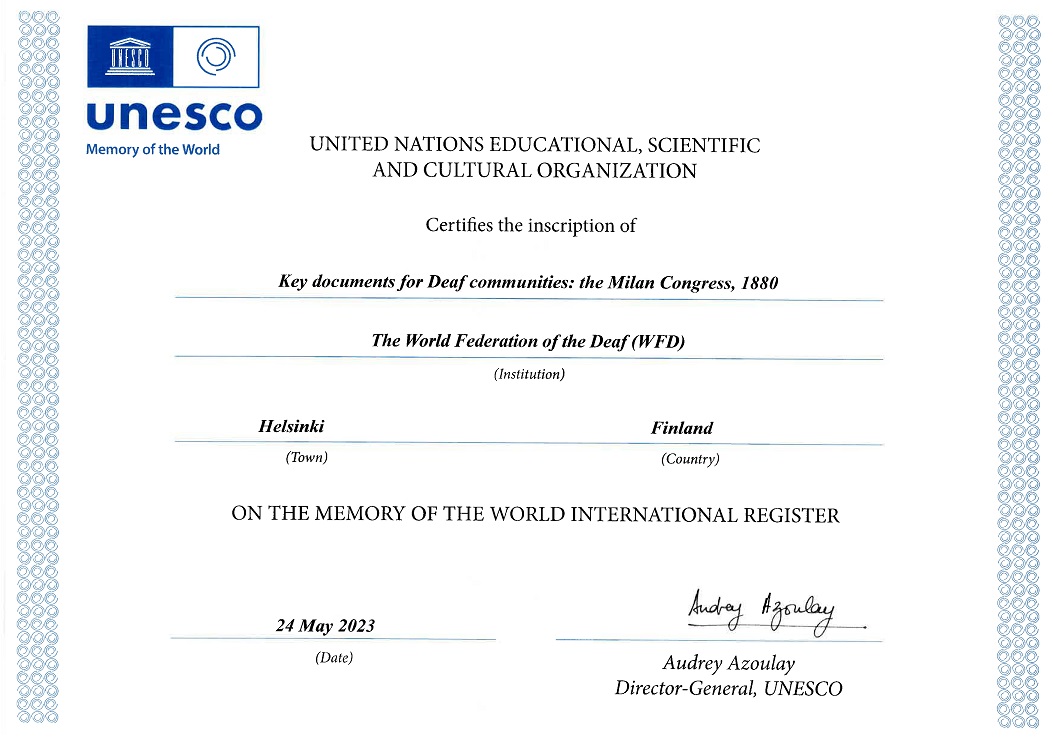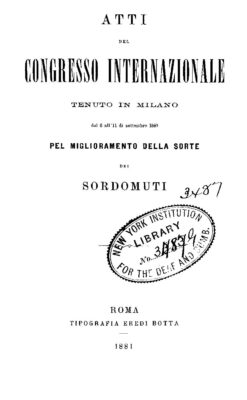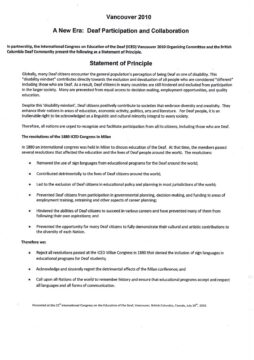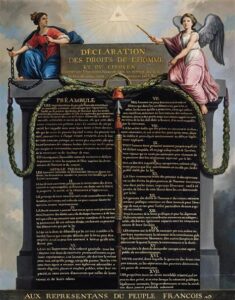UNESCO Memory of the World
of the 1880 Milan Congress
In 1880, the 2nd International Congress on the Education of the Deaf took place in Milan, Italy. Many see this Congress as symbolic of social change which impacted the lives of deaf individuals worldwide. At this congress, a resolution was passed, advocating for oralism over the use of sign language in deaf education. The Milan resolutions showcase how sign languages were devalued over time by societies. We are still living with the effects today, after generations of language deprivation and social marginalization for deaf people.
The WFD wants recognition for the history of deaf communities' struggle for recognition of our national sign languages. The World Federation of the Deaf, in collaboration with The Nippon Foundation, has collected three important reports from the Milan Congress and the 2010 Vancouver Resolution. This resolution, known as "The New Era Principles and Accord," rejects the harmful ideologies from the time of the Milan Congress and calls for the recognition and respect of all languages, including national sign languages.
We submitted these documents to UNESCO's Memory of the World Program, making history as the first inscription related to the history of deaf people. This recognition by UNESCO is a important step forward in advocating for the rights of deaf people to sign language and inclusive education- in our national sign languages.
The World Federation of the Deaf continues to work towards our vision: a world where deaf people can sign anywhere.





What is the UNESCO's Memory of the World program?
The UNESCO's Memory of the World program is a significant initiative aimed at preserving and promoting documentary heritage of universal value. It recognizes the importance of safeguarding and providing access to diverse cultural, historical, and scientific records from around the globe. This initiative seeks to raise awareness about the significance of preserving such heritage for future generations and to encourage international cooperation in this endeavor.
The Memory of the World program focuses on identifying and preserving valuable documents, including manuscripts, audiovisual materials, digital records, and artifacts, that contribute to humanity's collective memory and understanding. These could range from ancient manuscripts and rare books to audio recordings of significant historical events or cultural practices.
Through a rigorous selection process, UNESCO designates certain collections or individual items as "Memory of the World" treasures, highlighting their cultural significance and the need for their protection. These designated items are then included in the Memory of the World Register, which serves as a global repository of humanity's cultural heritage.
By promoting the preservation and accessibility of documentary heritage, the Memory of the World program plays a crucial role in fostering dialogue, education, and mutual understanding among peoples and nations. It helps to ensure that valuable records of human history, creativity, and knowledge are safeguarded for future generations to study, appreciate, and learn from.
Three examples of UNESCO's Memory of the World
- Gutenberg Bible (1455): The Gutenberg Bible, also known as the 42-line Bible, is one of the earliest major books printed using movable type in Europe. Produced by Johannes Gutenberg in Mainz, Germany, it marked a significant milestone in the history of printing and the dissemination of knowledge. Only around 48 copies of the Gutenberg Bible are known to exist today, making it an exceptionally rare and valuable cultural artifact.
Read more: https://www.unesco.org/en/memory-world/42-line-gutenberg-bible-printed-vellum-and-its-contemporary-documentary-background

- The Declaration of the Rights of Man and of the Citizen (1789): This revolutionary document adopted during the French Revolution proclaims fundamental rights such as liberty, equality, and fraternity. It has had a profound influence on movements for human rights worldwide and is considered a foundational text in modern human rights discourse.
Read more: https://www.unesco.org/en/memory-world/original-declaration-rights-man-and-citizen-1789-1791

- The Diary of Anne Frank (1947): The diary written by Anne Frank, a young Jewish girl who hid with her family during the Nazi occupation of the Netherlands, is a poignant and powerful document of the Holocaust era. Anne's diary provides a firsthand account of the daily struggles, fears, and hopes of a teenager living in hiding. It has been translated into numerous languages and has had a profound impact on readers worldwide, serving as a symbol of resilience, courage, and the human spirit in the face of adversity.
Read more: https://www.unesco.org/en/memory-world/diaries-anne-frank

